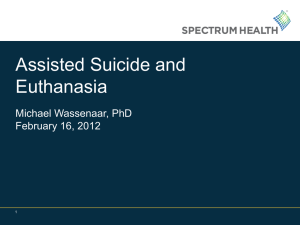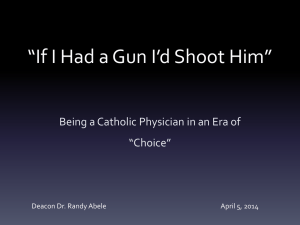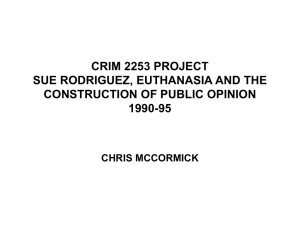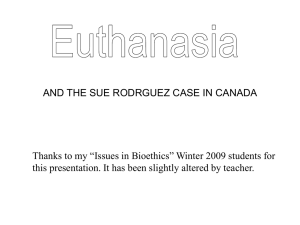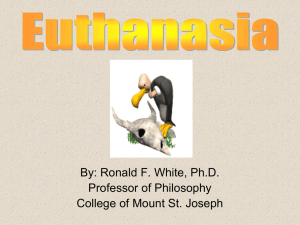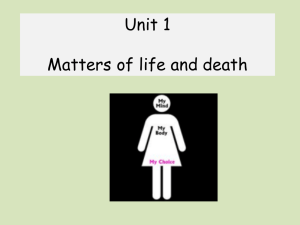American Medical Directors Association
advertisement
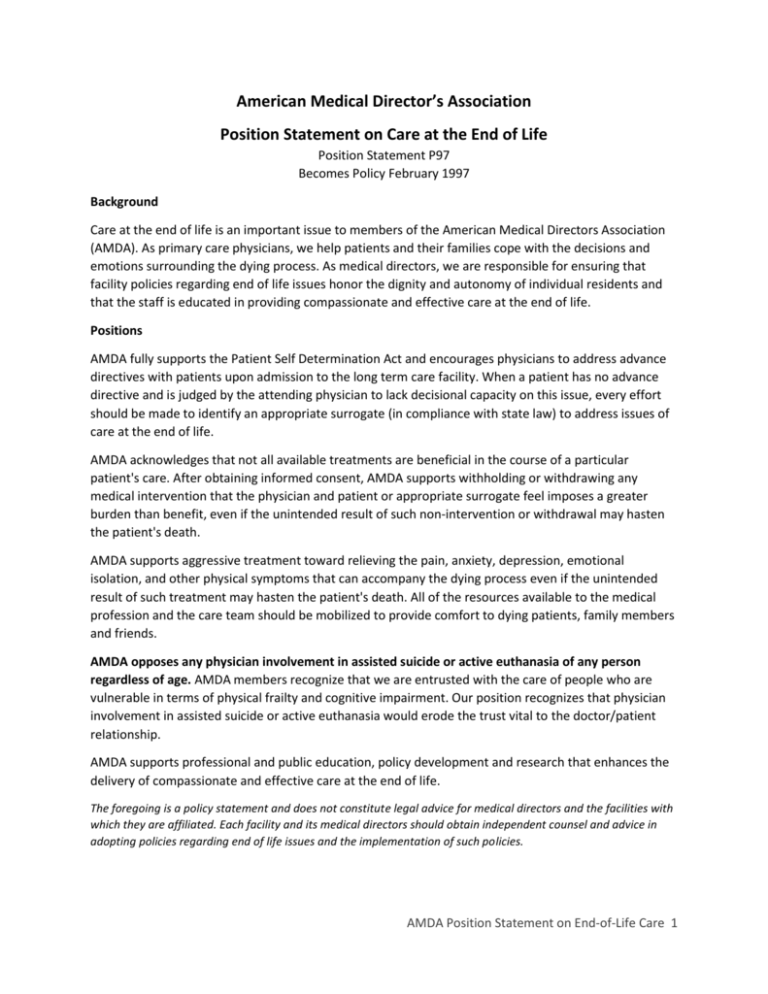
American Medical Director’s Association Position Statement on Care at the End of Life Position Statement P97 Becomes Policy February 1997 Background Care at the end of life is an important issue to members of the American Medical Directors Association (AMDA). As primary care physicians, we help patients and their families cope with the decisions and emotions surrounding the dying process. As medical directors, we are responsible for ensuring that facility policies regarding end of life issues honor the dignity and autonomy of individual residents and that the staff is educated in providing compassionate and effective care at the end of life. Positions AMDA fully supports the Patient Self Determination Act and encourages physicians to address advance directives with patients upon admission to the long term care facility. When a patient has no advance directive and is judged by the attending physician to lack decisional capacity on this issue, every effort should be made to identify an appropriate surrogate (in compliance with state law) to address issues of care at the end of life. AMDA acknowledges that not all available treatments are beneficial in the course of a particular patient's care. After obtaining informed consent, AMDA supports withholding or withdrawing any medical intervention that the physician and patient or appropriate surrogate feel imposes a greater burden than benefit, even if the unintended result of such non-intervention or withdrawal may hasten the patient's death. AMDA supports aggressive treatment toward relieving the pain, anxiety, depression, emotional isolation, and other physical symptoms that can accompany the dying process even if the unintended result of such treatment may hasten the patient's death. All of the resources available to the medical profession and the care team should be mobilized to provide comfort to dying patients, family members and friends. AMDA opposes any physician involvement in assisted suicide or active euthanasia of any person regardless of age. AMDA members recognize that we are entrusted with the care of people who are vulnerable in terms of physical frailty and cognitive impairment. Our position recognizes that physician involvement in assisted suicide or active euthanasia would erode the trust vital to the doctor/patient relationship. AMDA supports professional and public education, policy development and research that enhances the delivery of compassionate and effective care at the end of life. The foregoing is a policy statement and does not constitute legal advice for medical directors and the facilities with which they are affiliated. Each facility and its medical directors should obtain independent counsel and advice in adopting policies regarding end of life issues and the implementation of such policies. AMDA Position Statement on End-of-Life Care 1 References: Physician Assistance in Dying American Medical Association, Council on Ethical and Judicial Affairs. Decisions near the end of life. JAMA 1992;267:2229-33. American Medical Association. AMA position statement on physician assisted suicide. American Medical Association. Physician participation in capital punishment. JAMA 1993; 270:365-368. American Geriatrics Society. AGS position statement on voluntary active euthanasia. 1990. Annas GJ. The Promised End – Constitutional Aspects of Physician-Assisted Suicide. NEJM 1996;335:663-7. Annas GJ. Physician-assisted suicide – Michigan's temporary solution. NEJM 1993; 328:1573-1576. Angell M. Euthanasia in the Netherlands – Good news or bad? NEJM 1996;335:1676-1678. Angell M. The Supreme Court and physician-assisted suicide – the ultimate right. NEJM 1997;336:50-53. Asch D. The role of critical care nurses in euthanasia and assisted suicide. NEJM 1996; 334(21):1374-1379. Bachman JG, Aleser, KH, Doukas DJ, Lichtenstein RL, Corning AD, Brody H. Attitudes of Michigan Physicians and the Public Toward Legalizing Physician-Assisted Suicide and Voluntary Euthanasia. NEJM 1996;334(5):303-309. Battin M. Voluntary euthanasia and the risks of abuse: can we learn anything from the Netherlands? Law Med Health Care 1992;20:133-143. Beauchamp TL. Refusals of treatment and requests for death. Kennedy Institute of Ethics Journal 1996(6):372-374. Breo DL. MD-aided suicide vote down; both sides say debate to continue. JAMA 1991; 266:2895-2900. Brody H. Causing, intending, and assisting death. The Journal of Clin. Ethics 1933;4:12-117. Brody H. Assisted death – a compassionate response to a medical failure. NEJM 1992;327:1384-1388. Callahan D. Regulating Physician-Assisted Death. NEJM 1994;331(24):1656. Carton RW. The road to euthanasia. JAMA 1990;263:2221. Cassel CK, Meier DE. Morals and moralism in the debate over euthanasia and assisted suicide. NEJM 1990;323:750752. Cohen JS, Fihn SD, Boyko DJ, Jonsen AR, Wood RW. Attitudes Toward Assisted Suicide and Euthanasia Among Physicians in Washington State. NEJM 1994;331(2):89-94. Conwell Y, Caine ED. Rational Suicide and the right to die: reality and myth. NEJM 1991;325:1100-1103. Cotton P. Rational suicide: no longer 'crazy'? JAMA 1993;270:797. Council on Scientific Affairs, AMA. Good Care of the Dying Patient. JAMA 1996;275(6):474-478. Curtis P. Two Uncomfortable Stories of dying. Journal of Family Practice 1993;37(6):539-540. Dickey NW, Novack DH, Quill TE. Assisted Suicide and Other Ethical Dilemmas. Patient Care 1994 (March):77-91. Emanual EJ. This History of Euthanasia Debates in the United States and Britain. Annals of Int. Medicine 1994;121(10):793-802. Foley KM. Competent care for the dying instead of physician-assisted suicide. NEJM 1997;336:54-57. Glare PA, Tobin B. Euthanasia in Australia. NEJM 1996;334(25):1668-1669. Goodwin JS. Mercy killing: mercy for whom? JAMA 1991;265:326. Graber GC, Chassman J. Assisted suicide is not voluntary active euthanasia, but it's awfully close. JAGS 1993;41:8889. Hamel R. Physician-Assisted Suicide: Putting the Cart before the Horse. Second Opinion 1993 (July):84-86. Helm A. Debating euthanasia: an international perspective. Journal of Gerontological Nurs. 1984;20:20-24. Hinohara S. Sir William Osler's philosophy on death. Ann IM 1993;118:638-642. Horn M. Death on Trial. US News and World Report 1994 (April):31-41. Jecker NS. Giving death a hand: when the dying and the doctor stand in a special relationship. JAGS 1991;39:831835. Jecker NS. Physician-Assisted Death in the Netherlands and the United States: Ethical and Cultural Aspects of Health Policy Development. JAGS 1994;42:672-678. Kamisar Yale. Are Laws against Assisted Suicide Unconstitutional? Hastings Center Report. May-June, 1993:32-41. Kass LR. Is There a Right to Die? Hastings Center Report, Jan.-Feb.,1993:43. Kass LR, Lund N. Courting death: assisted suicide, doctors and the law. Commentary 1996(Dec):17-29. Kimura R. Death and dying in Japan. Kennedy Institute of Ethics Journal 1996(6):374-378. Knowlton L. A Time for Dying? NY Times 1994; (Sat., July 23):A2-B1. AMDA Position Statement on End-of-Life Care 2 Lamberg L. Treating Depression in Medical Conditions May Improve Quality of Life. JAMA 1996;276:857-858. Lee MA, Nelson HD et al, Legalizing Assisted Suicide – Views of Physicians in Oregon. NEJM 1996;334-310-5. Marzuk PM, Hirsch Cs, Leon AC, Stajic M, Hartwell N, Portera L. Increase in suicide by asphyxiation in New York City after the publication of Final Exit. NEJM 1993;329:1508-1510. Maas PJ, Pijnenborg L, Van Delden JM. Changes in Dutch Opinions on Active Euthanasia, 1966 through 1991. JAMA 1995;273(18):1411-1414. Matthews JC. The quality vs. the quantity of your life. Longevity 1990 (Nov):40-46. Miller DL. Pulling the Plug on Life? The Lutheran 1990(August):6-18. Miller FG, Quill TE, Brody H, Fletcher JC, Gostin LO, Meier DE. NEJM 1994;331(2):119-123. Misbin RI. Physician's aid in dying. NEJM 1991;325:1307-1311. Orentlicher DO. The Legalization of Physician-Assisted Suicide. NEJM 1996;335:663-7. Posner RA. Euthanasia and geronticide in Aging and Old Age. University of Chicago Press 1996;235-261. Quill TE, Cassel CK, Meier DE. Care of the hopelessly ill: proposed clinical criteria for physician-assisted suicide. NEJM 1992;327:1380-84. Quill TE. Death and Dignity. A Case of Individualized Decision Making. NEJM 1991;324:691-694. Quill TE. Doctor, I want to die. Will you help me? JAMA 1993;270:870-875. Quill TE. The ambiguity of clinical intentions. NEJM 1993;329:1039-1040. Scanlon C. Euthanasia and Nursing Practice - Right Question, Wrong Answer. NEJM 1996;334(21):1401-1402. Sedler RA. The Constitution and Hastening Inevitable Death. Hastings Center Report, Sept.-Oct. 1993;20-25. Singer PA, Siegler M. Euthanasia – a critique. NEJM 1990;322:1881-1883. Solomon A. A Death of One's Own. New Yorker 1995;(May22):54-69. Sprung CL. Changing attitudes and practices in forgoing life-sustaining treatments. JAMA 1990;263:2211-2215. Teno J, Lynn J. Voluntary active euthanasia: the individual case and public policy. JAGS 1991;39:827-830. Van Der Maas PJ, Van Delden JM, Pijnenborg L, Looman CWN. Euthanasia and other medical decisions concerning end of life. Lancet 1991;338:669-674. Van Der Maas PJ, et al. Euthanasia, physician-assisted suicide, and other medical practices involving the end of life in the Netherlands, 1990-1995. NEJM 1996; 335:1699-1705. Van Der Wall G, Muller MT, Christ LM, Ribbe MW, Van Eijk JTM. Voluntary Active Euthanasia and PhysicianAssisted Suicide in Dutch Nursing Homes: Requests and Administration. JAGS 1994;42:620-623. De Wachter MAM. Active euthanasia in the Netherlands. JAMA 1989;262:3316-3319. Wanzer SH, Federman DD, Adelstein SJ, et al. The physician's responsibility toward hopefully in patients. NEJM 1989;320:844-849. Watts DT, Howell T, Priefer BA. Geriatricians' attitudes toward assisting suicide of dementia patients. JAGS 1992;40:879-885. Watts DT, Howell T. Assisted suicide is not voluntary active euthanasia. JAGS 1992;40:1043-1046. Wildes, KWM. Death: a persistent controversial state. Kennedy Institute of Ethics Journal 1996(6):378-381. The above references served as background reading for formulating AMDA's policy on End of Life Care. They are not all-inclusive on the subject. AMDA Position Statement on End-of-Life Care 3
